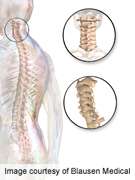(HealthDay)—Clinical and demographic variables can predict patients' expectations regarding anticipated improvement from cervical spine surgery, according to a study published June 15 in Spine.
Carol A. Mancuso, M.D., from the Hospital for Special Surgery in New York, and colleagues analyzed surveys completed by 150 patients (mean age 54 years; 61 percent male) several days before cervical surgery. The Expectations Survey comprises 20 physical and psychological items. Disability due to pain was evaluated with the Neck Disability Index (NDI), and overall physical and mental health was measured with the 12-item Short Form Health Survey.
The researchers found that the most commonly chosen items were relieve neck (87 percent) and upper extremity (85 percent) pain, stop the spine condition from getting worse (97 percent), and remove the control the spine condition had on life (96 percent). Patients were more likely to choose more items if they were younger (odds ratio [OR], 2.2; 95 percent confidence interval [CI], 1.2 to 4.0; P = 0.01), had worse NDI scores (OR, 6.5; 95 percent CI, 3.2 to 13.2; P < 0.0001), and had worse SF-12 Physical (OR, 1.9; 95 percent CI, 1.0 to 3.6; P = 0.05) and Mental Health scores (OR, 2.0; 95 percent CI, 1.1 to 3.6; P = 0.02) in multivariate analysis. Similarly, patients were more likely to have higher Expectations Survey scores (higher score = more expectations; mean score 65) if they were younger (OR, 2.8; P = 0.006) and had worse NDI scores (OR, 6.0; P < 0.0001).
"Multiple clinical variables were associated with expectations, with younger age and more disability due to pain being the most consistently associated with more expectations," the authors write.
More information:
Abstract
Full Text (subscription or payment may be required)
Journal information: Spine
Copyright © 2014 HealthDay. All rights reserved.























